
The Param Vir Chakra (roughly, the “Wheel of the Ultimate Brave”) is India’s highest military decoration for gallantry during battle and is “awarded for rarest of the rare gallantry which is beyond the call of duty and which in normal life is considered impossible to do”.
The medal is known for having one of the most stringent selection process of any military award in the world and 14 of the 24 total recipients were killed during the action that earned it. One such posthumous recipient was Yogendra Singh Yadav… The problem was that Yadav was very much alive and heard about his own heroic death while recovering in the hospital.Born in 1980 in the village of Aurangabad Ahir, Yadav was the son of former soldier who’d fought in the Indo-Pakistan wars as part of the Kumaon Regiment. Yadav, along with his brothers, would frequently spend evenings listening to their father’s war stories and tales of famous Indian military heroes. This instilled a deep sense of patriotism and duty in Yadav from a young age, so it was no surprise to his family when he decided to join the military at just 16 years old, joining the Grenadier Regiment.
Yadav subsequently proved to be a formidable asset to the military, quickly rising through the ranks and eventually coming to serve with an elite commando unit of the 18 Grenadiers called the Ghatak’s- basically, elite shock troops tasked with being the first boots on the ground in any conflict.
On May 3, 1999, Kashmiri and Pakistani militants managed to storm and take control of several strategic forts and bunkers along the border that had been left abandoned since the end of the war.
This action prompted the start of what became known as the Kargil Conflict- a series of bloody confrontations between the two countries that lasted just over 3 months.One of the most strategically valuable points captured was a group of fortified hardpoints atop a 17,411 foot (5,307 m) tall mountain known colloquially as “Tiger Hill”, or officially as Point 4660. As the tallest peak in the Kargil region, Tiger Hill allowed the enemy soldiers to look down on the 56 Brigade’s headquarters, as well as watch the Srinagar-Leh highway for troop and supply movements. Unsurprisingly, the top Indian military brass demanded its immediate recapture at any cost- enter Yadav’s commando platoon, the 18 Grenadiers.
The mission of the 18 Grenadiers (which has been called one of the most brazen ever attempted in open combat) was to scale an icy, 1000 foot near vertical section of the mountain and assault the 3 fortified bunkers atop it, while artillery bombardments distracted the combined Pakistani Kashmiri forces stationed in them.
Yadav (who was just 19 years old at this point) wasted no time volunteering to climb the snow-covered peak unassisted and lead the assault. Yadav’s mission was to affix ropes to specific areas so that the rest of the near couple dozen 18 Grenadiers squad could follow him more quickly.
Trained in both mountaineering and alpine warfare, Yadav was an exceptional climber and was reportedly able to scale half that section of the mountain in mere minutes- a feat that becomes all the more impressive when you realise this assault began at night (roughly 11pm local time) and the elevation in that area is approximately 17,000 feet (5,100 meters), meaning light and oxygen levels wouldn’t exactly have been ideal for such fast climbing.
Unfortunately for Yadav, as he was closing on the top of the mountain, with his platoon now following closely behind, he was spotted and the enemy opened fire with machine-guns and rocket launchers.
The initial volley killed Yadav’s commanding officer along…
The post Yadav and the Param Vir Chakra appeared first on FeedBox.